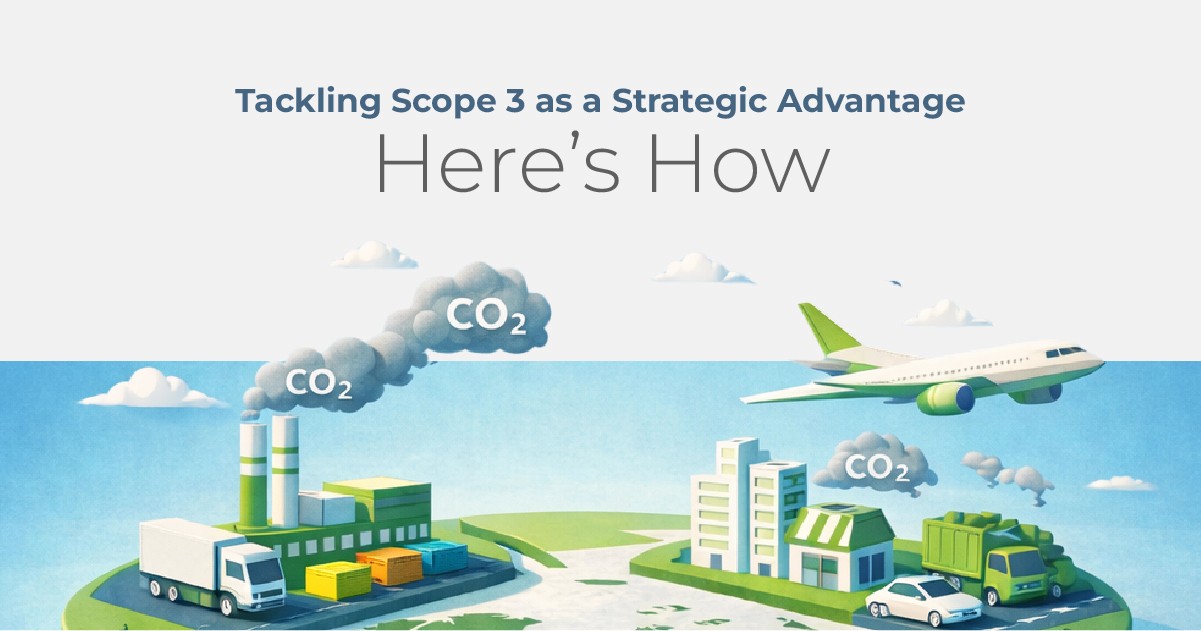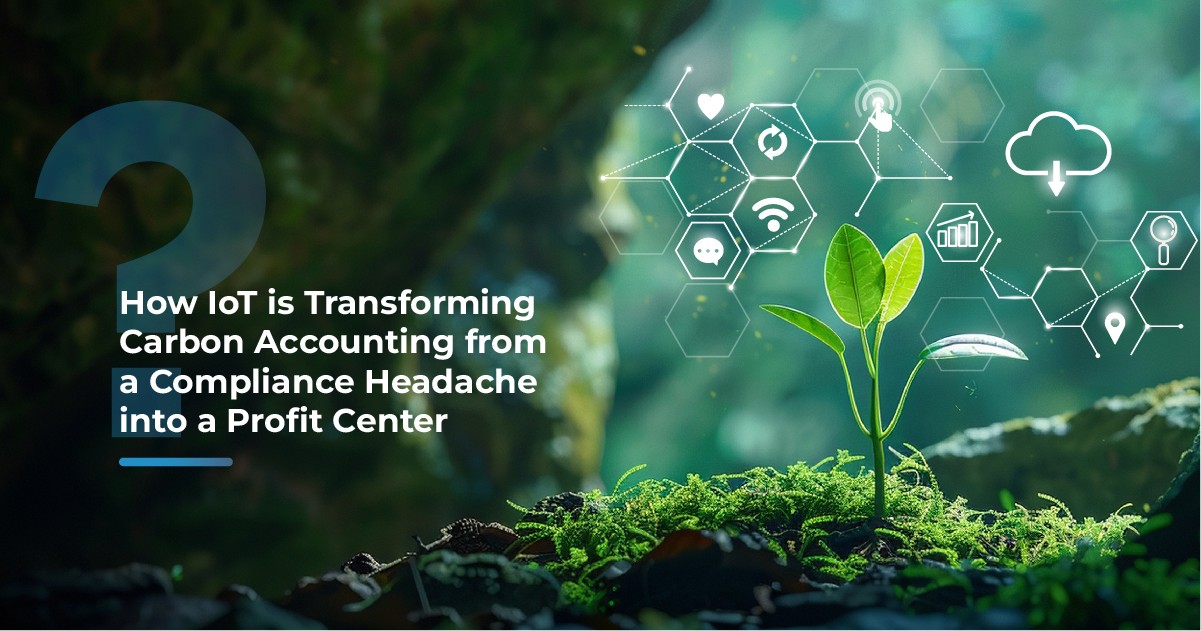The Hidden Carbon Footprint: Scope 3 Emissions
Scope 3 emissions the indirect greenhouse gases produced across a company’s value chain often represent the largest share of a business's carbon footprint, sometimes accounting for up to 95% of total emissions.
For instance, Microsoft reported that 97% of its carbon footprint stems from Scope 3 emissions, primarily due to its extensive supply chain and product use by consumers, The Wall Street Journal.
Similarly, Nestlé disclosed that 95.8% of its emissions are Scope 3, underscoring the significance of supplier-related emissions in the food and beverage sector carbonmaps.io.
The Challenges: Complexity, Data Gaps, and Standardisation

Despite their prominence, tracking Scope 3 emissions poses significant challenges:
Complex Supply Chains: Companies often have extensive and intricate supply chains, making it difficult to obtain comprehensive emissions data from all suppliers.
Data Gaps and Inconsistencies: A 2024 survey by the Science Based Targets initiative (SBTi) revealed that 85% of companies struggle with accessing accurate emissions data, particularly from suppliers, due to insufficient data and inconsistent reporting standards Aligned Incentives.
Lack of Standardisation: The absence of uniform reporting frameworks across industries leads to discrepancies in emissions data, complicating efforts to aggregate and compare information.
The Promise: Simplifying Supplier Emission Tracking
Despite these challenges, effective Scope 3 tracking is not only feasible but also essential. By implementing streamlined measurement tools, automating data collection, and fostering transparent supplier engagement, companies can gain actionable insights into their supply chain emissions. This proactive approach enables businesses to meet regulatory requirements, enhance sustainability performance, and build stronger relationships with environmentally conscious consumers and investors.
Understanding Scope 3 Emissions
What Are Scope 3 Emissions?
Scope 3 emissions are indirect greenhouse gas (GHG) emissions that occur across a company’s value chain, both upstream and downstream. Unlike Scope 1 (direct emissions from owned sources) and Scope 2 (indirect emissions from purchased energy), Scope 3 is outside the direct control of a company but often represents the largest portion of its carbon footprint.
Fact: According to CDP data (2023), up to 80–90% of emissions in sectors like retail, food & beverage, and electronics come from Scope 3.
Examples Across Industries
1. Manufacturing
Emissions from raw material extraction, production, and transportation.
Example: Steel or cement manufacturers often see 70–80% of total emissions in their supply chains.
2. Retail & Consumer Goods
Emissions from product use, packaging, and supplier operations.
Example: Nestlé reports 95.8% of emissions are Scope 3, mainly from suppliers and product use.
3. Logistics & Transportation
Emissions from third-party shipping, distribution, and fuel use.
Example: Companies using global shipping networks face high indirect emissions, often exceeding direct operational emissions.
4. Food & Beverage
Emissions from agriculture, processing, and distribution.
Example: Dairy and meat supply chains are particularly carbon-intensive, with upstream emissions dominating total footprint.
Why Scope 3 Often Dominates Carbon Footprints
Extensive Supply Chains – Complex networks across multiple regions make emissions tracking difficult.
Downstream Impact – Products’ usage and disposal often contribute more emissions than production.
Data Gaps – Many suppliers lack reliable reporting, leading to underestimation of footprint if not measured carefully.
The Business Case for Tracking Scope 3

Compliance with Global Standards
Governments and international frameworks increasingly require value chain emissions reporting.
Example: The EU Carbon Border Adjustment Mechanism (CBAM), starting in 2026, will affect Indian exporters in steel, cement, and chemicals. Accurate Scope 3 tracking ensures businesses remain compliant and avoid penalties.
Global standards like GHG Protocol, CDP, and SBTi explicitly include Scope 3 in their guidelines, making tracking essential for audit-ready reporting.
Investor and Buyer Expectations
Investors prioritise climate-resilient businesses with transparent emissions disclosures.
MSCI ESG research (2023) shows companies with strong carbon reporting enjoy lower capital costs and higher investor confidence.
Buyers increasingly demand sustainable supply chains: NielsenIQ reports 73% of consumers prefer products from environmentally responsible brands.
Cost Savings and Operational Efficiency
Tracking Scope 3 helps identify emission hotspots in the supply chain, often highlighting energy inefficiencies, waste, or high-impact materials.
McKinsey & Company research shows that businesses systematically managing emissions can achieve up to 20% savings on energy and operational costs.
For Indian SMEs, even small efficiency gains translate to significant improvements in margins.
Competitive Advantage and Risk Mitigation
Early adoption of Scope 3 tracking positions companies as leaders in sustainability, differentiating them in global markets.
Understanding supplier emissions helps anticipate supply chain disruptions, manage climate-related risks, and maintain continuity.
Demonstrating measurable reduction in supply chain emissions builds buyer trust, strengthens ESG credibility, and opens doors to new markets and partnerships.
Common Challenges in Supplier Emission Tracking
Tracking Scope 3 emissions across suppliers is inherently complex. Businesses face multiple hurdles:
Data Availability and Reliability
Many suppliers, especially SMEs, lack robust measurement systems.
According to a 2024 SBTi survey, 85% of companies report difficulty obtaining accurate emissions data from their supply chains.
Inconsistent or incomplete data can lead to underreporting or errors, undermining sustainability initiatives.
Complex Supplier Networks
Multinational businesses may have hundreds or thousands of suppliers across multiple geographies.
Tracking emissions from every tier, including sub-suppliers, is a logistical and technical challenge.
Limited Internal Expertise
Many organisations lack trained personnel to analyse Scope 3 emissions or engage suppliers effectively.
The World Bank (2024) reports that 65% of SMEs in emerging markets cite lack of knowledge as a key barrier to sustainability reporting.
Inconsistent Reporting Standards
Different industries and regions follow varying frameworks, leading to discrepancies in methodology and comparability.
Without standardisation, aggregating supplier data becomes time-consuming and prone to errors.
Supplier Engagement and Collaboration
Encouraging suppliers to measure and report emissions requires training, incentives, and long-term collaboration.
Resistance or low awareness among suppliers can delay progress, especially in industries with fragmented supply chains.
The Onlygood Approach to Scope 3 Tracking
At Onlygood, we make Scope 3 emission tracking accessible, actionable, and achievable for businesses of all sizes. Our approach tackles the common challenges while turning supplier emissions into strategic insights.
Simplified Measurement and Supplier Engagement
Intuitive dashboards and calculators allow businesses to measure emissions across suppliers without specialised expertise.
Onlygood provides step-by-step guidance for suppliers, enabling consistent and accurate reporting across the value chain.
Automated Data Collection and Reporting
Integration with supplier systems, transport logs, and procurement platforms automates data capture.
Reports are audit-ready and aligned with global standards such as GHG Protocol and CDP, reducing manual errors and time spent on reporting.
Actionable Insights for High-Impact Reduction
Our platform identifies emission hotspots in the supply chain, helping companies prioritise suppliers and processes for reduction.
Businesses can implement targeted strategies that maximise both environmental and operational impact.
Tailored Solutions Across Industries
Onlygood adapts to different industries and company sizes, from manufacturing to retail to food & beverage.
Guidance includes templates, best practices, and supplier engagement tools to meet industry-specific regulatory and sustainability requirements.
Turning Sustainability into Growth
By simplifying Scope 3 tracking, Onlygood empowers businesses to leverage sustainability as a competitive advantage.
Accurate measurement and proactive reduction strategies help build buyer trust, attract investors, and unlock operational efficiencies.
Benefits of Effective Supplier Emission Tracking

Implementing Scope 3 tracking with Onlygood delivers measurable value beyond compliance. Key benefits include:
Compliance Readiness and Audit-Friendly Reporting
Aligns with GHG Protocol, CDP, SBTi, and upcoming regulations like EU CBAM.
Reduces risk of fines, penalties, or lost market access.
Companies with transparent supply chain reporting are 30% less likely to face regulatory challenges (CDP, 2024).
Reduced Carbon Footprint Across the Value Chain
Identifying high-impact suppliers allows targeted interventions.
Streamlined data collection ensures accurate measurement and continuous improvement.
Businesses can demonstrate real environmental impact, strengthening ESG credibility.
Strengthened Buyer and Investor Trust
Transparency signals accountability and resilience.
According to NielsenIQ, 73% of consumers prefer sustainable brands.
Investors increasingly favour companies with clear emissions data, often enjoying lower capital costs (MSCI ESG, 2023).
Operational Efficiency and Cost Savings
Emission hotspots often overlap with energy inefficiencies or process waste.
McKinsey research shows structured measurement can reduce energy and operational costs by up to 20%.
Optimising supplier processes improves both sustainability and profit margins.
Competitive Advantage in Global Markets
Demonstrating measurable reductions in supplier emissions differentiates businesses in export markets.
Builds stronger relationships with climate-conscious buyers and long-term partners.
Early adoption positions companies as leaders in sustainable supply chains.
Scope 3 and the Future of Supply Chain Sustainability
The importance of Scope 3 emissions is only set to grow. Companies that proactively track and reduce supplier emissions will be better positioned to thrive in a climate-conscious global economy.
Key Trends Shaping the Future
Increasing Regulatory Focus
Global policies, such as EU CBAM and evolving ESG disclosure frameworks, are pushing companies to report upstream and downstream emissions.
Early adopters of Scope 3 tracking gain regulatory compliance and avoid market penalties.
Integration Into Corporate Strategy
Scope 3 tracking is moving from a reporting requirement to a strategic tool.
Insights from supplier emissions guide procurement decisions, supplier partnerships, and product innovation, linking sustainability directly to growth.
Technology-Driven Efficiency
Automation, AI, and IoT enable faster, more accurate, and actionable data collection.
Digital tools reduce manual effort, increase supplier engagement, and allow continuous monitoring of carbon impact across the value chain.
Investor and Consumer Expectations
Investors are increasingly favouring businesses with transparent and verified Scope 3 emissions data.
Consumers continue to shift toward brands demonstrating real sustainability impact, creating a competitive advantage for proactive companies.
Onlygood’s Vision
At Onlygood, we aim to make Scope 3 measurement accessible, actionable, and achievable. By simplifying supplier emission tracking, we help businesses turn compliance into growth, reduce environmental impact, and strengthen their position in global markets.





